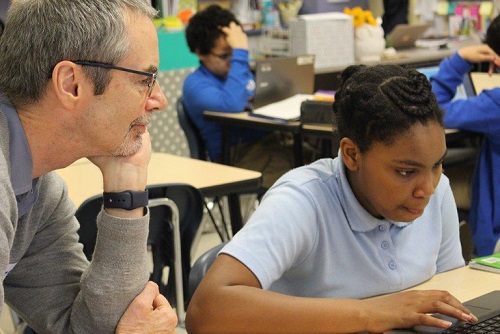Research & Insights / Using Technology & Blended Learning Models to Increase Time for Direct Intervention
Using Technology & Blended Learning Models to Increase Time for Direct Intervention

By Derek Doherty, 8th grade math teacher, Mildred Avenue K-8
If you ask math teachers across the city for a wish-list of things that could help accelerate learning and growth in their classroom, nearly every teacher would agree that **more time for small-group and 1-on-1 Interventions** should be at or near the top of the list. Dedicating time for small-group and 1-on-1 interventions can be a challenge, especially in large classes including many students who lag behind in key foundational understandings and procedural skills needed to access grade-level work. We know that student misconceptions and skill-gaps are most effectively addressed with individualized interventions. How can teachers find the time to provide interventions for each student who needs the extra support, while still ensuring that every student in the class is productively struggling, supported and growing?
At the Mildred Avenue K-8 School in Mattapan, our teachers have turned to technology and blended learning models to help meet this challenge. In partnership with EdVestors as part of the Zeroing in on Math initiative (ZioM), we received a technology grant to fund student licenses for innovative math software programs like TenMarks, Carnegie Learning, and ST Math. Our math teachers have been experimenting with these programs and various blended learning models for the past two years. When used effectively, these programs have helped keep each student in the class productively challenged at their own pace, and importantly, have freed up more time for our teachers to provide personalized small group interventions.
“It’s (integrating software in the classroom) helped all of our mathematicians increase their time on task each day, and the instant feedback paired with appropriate rigor helps keep our students engaged and learning after having already spent 75 minutes in a math class earlier in the day.”
By increasing the amount of time that students spend productively engaged in Math and ensuring they get more Intervention support when needed, we’ve been able to move many more students towards proficiency in Math and post some of the strongest growth numbers in BPS.[\[2\]](#_ftn2) In fact, Mildred Avenue had the fourth highest math student growth scores in Massachusetts in 2015. After years of struggling as one of the lowest performing schools in the state, this growth in Math has in turn helped the Mildred become the first Level 1 school in Mattapan. We hope to continue supporting even more of our students towards math proficency by continuing to refine our most successful blended learning models and building on lessons learned both from teachers within our building and from other schools pursuing similar work in the ZioM cohort.
“Students who had a strong understanding of key concepts from that day’s lesson are able to quickly refine and master their skills before moving onto new content or more challenging items, while students who need more time to reach procedural fluency have the freedom to do so at their own speed.”
What We Learned
1. Use software programs as a supplement, not a replacement for core instruction. Whether software is used as part of a station-based rotational model or by the entire class during an Intervention block, we’ve found it most successful to tackle content using a software program after that content was first introduced in a more traditional setting. These programs work best when students have first had a chance to explore key concepts from a math standard with their teacher and classmates, and then use the software to deepen conceptual understandings, refine procedural skills, and provide exposure to rigorous application items within that standard.
2. Focus on exploring the tools available for students instead of helping students with specific content issues. Too often when students struggle with content on a software program, our first inclination is to help them work through the problem and better their understanding of the content within that item. But the real power of programs like TenMarks and ST Math is through the tools they have available to help students drive their own learning: Hints, Videos, Amplifiers & Do-Overs, and most importantly, instant feedback and in-depth explanations after answering each item. As teachers, we should be focused on helping students explore these tools and helping them realize that making mistakes and learning from the explanations is the best way to grow their brain and increase their scores on a given software program.
3. Use groupings to streamline the process of individualizing student work. Another key benefit of using software is the ability to individualize the content each student explores. We know that assigning the same lesson(s) to every student is less than ideal, but also lack the time necessary to assign appropriate, individualized work for each of the 75+ students we teach. By putting students into “groups” -- e.g., (1) students who need more foundational work to access the grade-level content, (2) students who need more practice within grade-level standards, and (3) students who have mastered the current content and need more challenging work -- we were able to assign targeted work for each of our students that kept them productively engaged, while leaving our teachers with more time to analyze data, reflect on their practice, and plan accordingly.
Indeed, in addition to observations in the classroom, the data from these programs is one of the key tools our teachers use in identifying which students need extra support.
Mildred’s median SGP of 60.0 ranked #1 out of the 34 BPS middle schools or K-8 schools that took the 2016 PARCC Math assessment.



